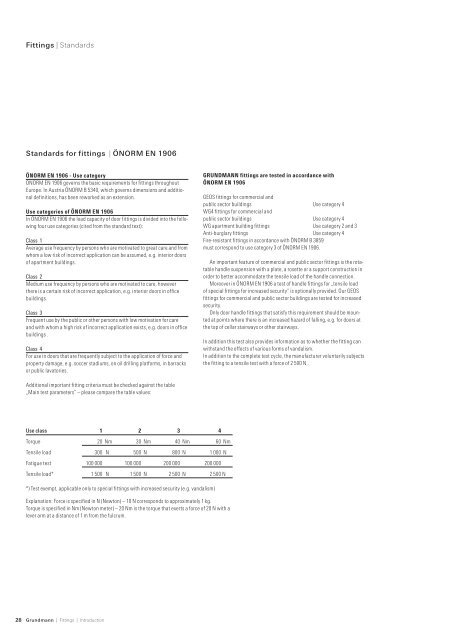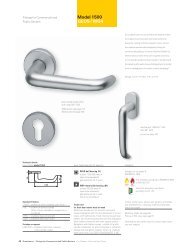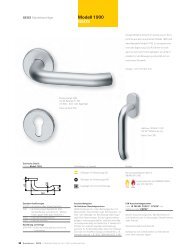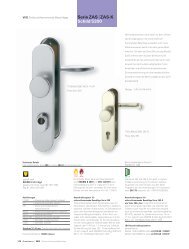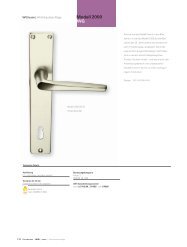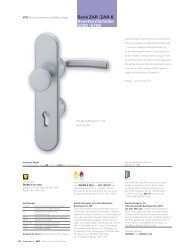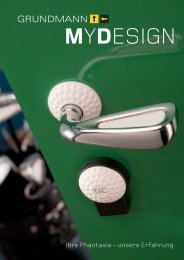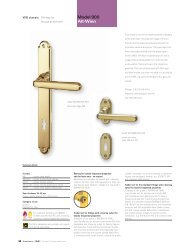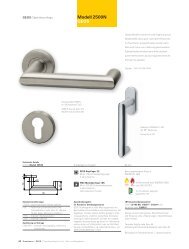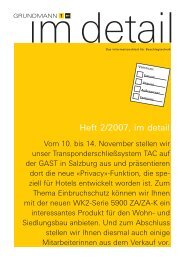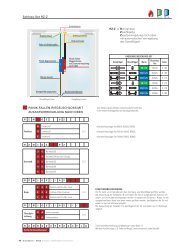CATALOGUE 2010/11 - Grundmann Beschlagtechnik GmbH
CATALOGUE 2010/11 - Grundmann Beschlagtechnik GmbH
CATALOGUE 2010/11 - Grundmann Beschlagtechnik GmbH
You also want an ePaper? Increase the reach of your titles
YUMPU automatically turns print PDFs into web optimized ePapers that Google loves.
Fittings | Standards<br />
Standards for fittings | ÖNORM EN 1906<br />
ÖNORM EN 1906 - Use category<br />
ÖNORM EN 1906 governs the basic requirements for fittings throughout<br />
Europe. In Austria ÖNORM B 5340, which governs dimensions and additional<br />
definitions, has been reworked as an extension.<br />
Use categories of ÖNORM EN 1906<br />
In ÖNORM EN 1906 the load capacity of door fittings is divided into the following<br />
four use categories (cited from the standard text):<br />
Class 1<br />
Average use frequency by persons who are motivated to great care and from<br />
whom a low risk of incorrect application can be assumed, e.g. interior doors<br />
of apartment buildings.<br />
Class 2<br />
Medium use frequency by persons who are motivated to care, however<br />
there is a certain risk of incorrect application, e.g. interior doors in office<br />
buildings.<br />
Class 3<br />
Frequent use by the public or other persons with low motivation for care<br />
and with whom a high risk of incorrect application exists, e.g. doors in office<br />
buildings .<br />
Class 4<br />
For use in doors that are frequently subject to the application of force and<br />
property damage, e.g. soccer stadiums, on oil drilling platforms, in barracks<br />
or public lavatories.<br />
GRUNDMANN fittings are tested in accordance with<br />
ÖNORM EN 1906<br />
GEOS fittings for commercial and<br />
public sector buildings Use category 4<br />
WG4 fittings for commercial and<br />
public sector buildings Use category 4<br />
WG apartment building fittings Use category 2 and 3<br />
Anti-burglary fittings Use category 4<br />
Fire-resistant fittings in accordance with ÖNORM B 3859<br />
must correspond to use category 3 of ÖNORM EN 1906.<br />
An important feature of commercial and public sector fittings is the rotatable<br />
handle suspension with a plate, a rosette or a support construction in<br />
order to better accommodate the tensile load of the handle connection.<br />
Moreover in ÖNORM EN 1906 a test of handle fittings for „tensile load<br />
of special fittings for increased security“ is optionally provided. Our GEOS<br />
fittings for commercial and public sector buildings are tested for increased<br />
security.<br />
Only door handle fittings that satisfy this requirement should be mounted<br />
at points where there is an increased hazard of falling, e.g. for doors at<br />
the top of cellar stairways or other stairways.<br />
In addition this test also provides information as to whether the fitting can<br />
withstand the effects of various forms of vandalism.<br />
In addition to the complete test cycle, the manufacturer voluntarily subjects<br />
the fitting to a tensile test with a force of 2 500 N .<br />
Additional important fitting criteria must be checked against the table<br />
„Main test parameters“ – please compare the table values:<br />
Use class 1 2 3 4<br />
Torque 20 Nm 30 Nm 40 Nm 60 Nm<br />
Tensile load 300 N 500 N 800 N 1 000 N<br />
Fatigue test 100 000 100 000 200 000 200 000<br />
Tensile load* 1 500 N 1 500 N 2 500 N 2 500 N<br />
*) Test exempt, applicable only to special fittings with increased security (e.g. vandalism)<br />
Explanation: Force is specified in N (Newton) – 10 N corresponds to approximately 1 kg.<br />
Torque is specified in Nm (Newton meter) – 20 Nm is the torque that exerts a force of 20 N with a<br />
lever arm at a distance of 1 m from the fulcrum.<br />
28 <strong>Grundmann</strong> | Fittings | Introduction


